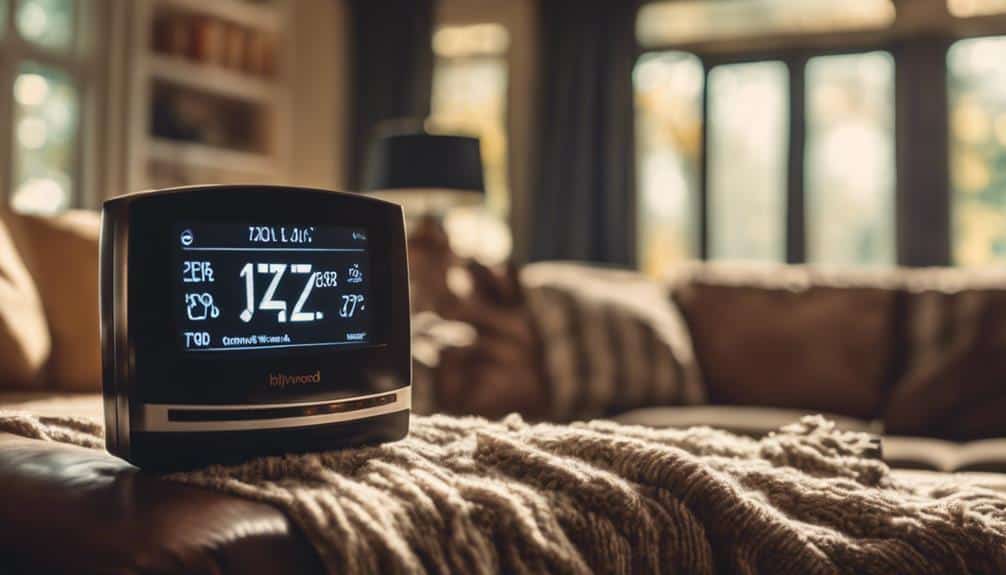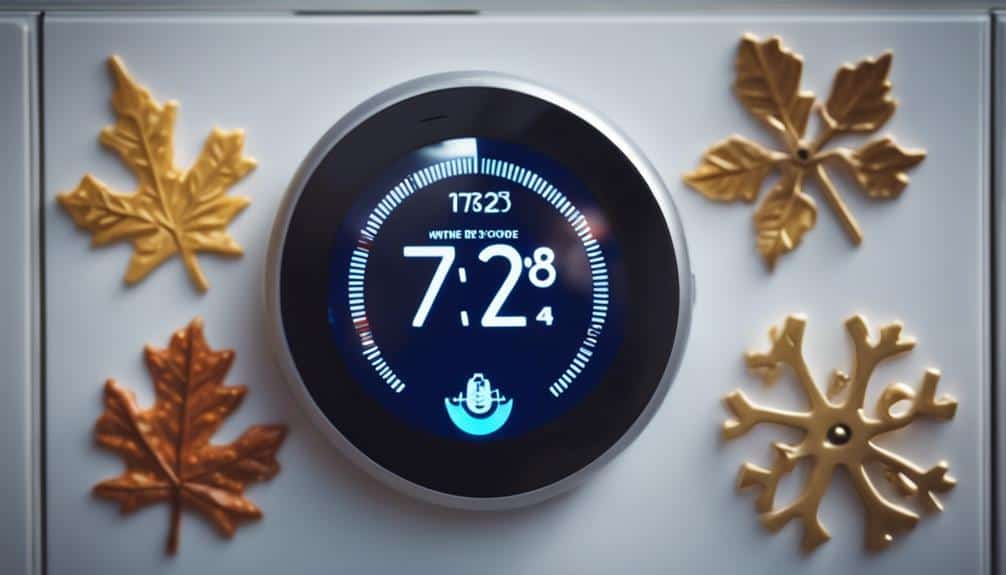Exploring the seasons in your home is like embarking on a voyage through changing climates, requiring a keen understanding of your climate control system to keep the journey smooth.
You've got the tools—a thermostat, insulation, and HVAC system—but do you know how to use them effectively as the weather shifts? By making small adjustments and understanding the nuances of your system, you'll not only enhance your comfort but also greatly cut down on energy bills.
Let's explore how to fine-tune your approach to climate control, ensuring you're well-equipped for whatever the weather throws your way, without breaking a sweat or the bank.
Key Takeaways
- Schedule HVAC maintenance in spring and fall to enhance system efficiency and longevity.
- Adjust thermostat settings seasonally for energy savings and optimal comfort.
- Improve home insulation to reduce reliance on HVAC and lower energy costs.
- Choose Energy Star certified products for better energy efficiency and potential rebates.
Spring HVAC Preparation
As spring approaches, it's time to get your HVAC system ready, ensuring a comfortable home throughout the season. Start with scheduling professional HVAC maintenance to keep your system running smoothly.
Don't forget to change or clean your air filters, a simple step that greatly improves indoor air quality and the efficiency of your system. Also, inspect your home for any air leaks or gaps and seal them to maintain consistent indoor temperatures and reduce energy waste.
Cleaning coils and ducts is important for enhancing your system's operation and energy efficiency. Finally, consider upgrading to a programmable thermostat. This handy device allows for automated temperature adjustments, making it easier to maintain the perfect comfort level while also saving on energy costs.
Summer Thermostat Strategies

Adjusting your thermostat effectively during the summer can greatly reduce cooling costs while keeping you comfortable. Set your thermostat to 78°F when you're home to strike a balance between comfort and energy efficiency. If you're out for more than two hours, bump it up to 85-88°F. This small adjustment could slash your cooling costs by up to 10%.
Gradually adjusting your thermostat helps your body get used to the change, making those hotter days more bearable. Be cautious with thermostat settings during summer nights; setting it too low can lead to unnecessary energy use.
Consider investing in smart thermostats. They're brilliant at creating customized schedules that ensure optimal comfort and energy savings, making your summer both cool and cost-effective.
Fall Climate Adjustments

As fall arrives, it's time to adjust your thermostat settings and check for drafts around your home. Lowering the temperature when you're asleep or away can greatly cut your heating bills.
Sealing leaks keeps the warmth in. These simple steps guarantee you stay cozy without overspending.
Adjust Thermostat Settings
With fall's arrival, it's key to tweak your thermostat to maintain both comfort and energy efficiency. As the leaves change, so should your approach to managing your home's climate. Here's how to adjust your settings for the best balance:
- Set your thermostat to 68°F during daylight hours to keep a comfortable and energy-efficient environment.
- Lower it to 65°F at night to enjoy energy savings and cozy sleep.
- When you're away, adjust down to 60°F to cut costs without sacrificing comfort upon return.
- Gradually acclimate to these cooler temperatures for efficient heating throughout the autumn season.
Embracing these adjustments can lead to significant energy savings while ensuring your home remains a haven of comfort as the weather cools.
Seal Drafts and Leaks
Sealing drafts and leaks around your home is a fundamental step to keep warmth in and cold out during the fall. By taking the time to insulate gaps and cracks, you're not just preventing the chill from seeping in; you're also reducing energy waste greatly.
Weatherstripping windows and doors is another effective way to fend off cold drafts, ensuring a cozy and comfortable indoor atmosphere. Don't overlook the importance of addressing air leaks in ductwork and vents; doing so can greatly optimize your heating efficiency.
Winter Heating Tips

As winter approaches, it's essential you take steps to keep your home cozy without breaking the bank.
Insulating your living spaces properly guarantees heat stays in, while smart thermostat usage can greatly cut down on your bills.
Let's explore how you can optimize these strategies for warmer, more efficient living through the colder months.
Insulate to Retain Heat
To keep your home cozy during the winter, proper insulation is key in retaining heat and cutting down on energy use. By addressing heat loss, you not only enhance heating efficiency but also reduce energy consumption, leading to a snugger home.
Consider these steps to bolster your winter comfort:
- Upgrade attic insulation: Attics are prime spots for heat to escape, so make sure they're well-insulated.
- Seal walls and floors: Prevent cold air infiltration and warmth exiting by insulating these areas.
- Invest in quality materials: Higher-grade insulation can dramatically improve your home's warmth retention.
- Regular inspections: Check for gaps or deterioration annually to maintain the best insulation performance.
Investing in these areas can significantly improve your home's ability to retain warmth during colder months, ensuring a more comfortable and energy-efficient winter season.
Smart Thermostat Usage
Harness the power of technology this winter by optimizing your heating with a smart thermostat, ensuring comfort while saving on energy costs.
Set your smart thermostat to a cozy 68-72°F during the day for ideal comfort and energy efficiency. When it's time to snuggle into bed, lower the temperature to 62-66°F. You'll save on heating costs without sacrificing comfort.
Use smart programming to gradually adjust temperatures throughout the evening, tailoring your home's warmth to your personal schedule.
Upgrade to a smart thermostat for remote access, giving you control over your winter heating settings from anywhere. Remember, smart thermostats can slash your heating costs by up to 15% by efficiently managing temperature settings.
Stay warm, save money, and enjoy the season.
Year-Round Maintenance Essentials

Maintaining your home to stay comfortable and energy-efficient year-round requires following a few maintenance essentials. Keeping your HVAC system in top shape not only reduces your heating and energy costs but also guarantees proper airflow and a consistent indoor temperature.
Here's how you can make it happen:
- Regularly Change Air Filters: Swap them out in spring, fall, and winter to improve HVAC efficiency and air quality.
- Schedule Maintenance Service: Have a professional check your system in spring and fall to prevent breakdowns.
- Inspect for Leaks: In spring, look for gaps and poor insulation to maintain an even temperature.
- Clean Coils and Ducts: Do this in spring; keep units clean in summer for best operation.
Following these steps will keep your home cozy and your bills low, no matter the season.
Energy-Efficient Equipment Upgrades

Upgrading your home's HVAC to energy-efficient models can slash your heating and cooling costs by up to 20%. By choosing Energy Star certified equipment, you're not just saving money, but also ensuring peak performance with lower energy consumption. Let's break down the benefits:
| Feature | Benefit | Impact |
|---|---|---|
| Variable-speed technology | Adjusts cooling and heating output | Reduces energy use |
| Energy Star Certification | Guarantees efficiency | Lowers bills & carbon footprint |
| Rebates and Incentives | Financial savings on purchase | Makes upgrades affordable |
Investing in upgraded equipment doesn't just cut costs; it lowers your carbon footprint. Plus, you might qualify for rebates and incentives, making this smart choice even wiser.
Seasonal Insulation Techniques

After exploring energy-efficient HVAC upgrades, let's focus on seasonal insulation techniques to further optimize your home's climate control and reduce energy costs.
Insulation isn't just a one-time deal; it requires seasonal adjustments to maintain energy efficiency and keep your indoor temperatures steady. Here's how you can make it happen:
- Insulate Windows and Doors: Prevent heat loss and cut down on energy bills.
- Seal Gaps and Cracks: Enhance insulation effectiveness by sealing gaps in walls, floors, and ceilings.
- Adjust Insulation Seasonally: Adapt your insulation methods to better regulate indoor comfort levels.
- Reduce HVAC Workload: With proper insulation, you'll rely less on your HVAC, leading to significant cost savings.
Smart Thermostat Benefits

Switching to a smart thermostat can greatly lower your heating and cooling costs while enhancing your home's comfort. With remote adjustments and advanced learning capabilities, a smart thermostat offers personalized comfort effortlessly. You can control your home's climate from anywhere using a smartphone app, voice assistant, or web interface, making it convenient to save energy without sacrificing comfort.
| Feature | Benefit | Impact |
|---|---|---|
| Remote Adjustments | Control from anywhere | Convenience & Energy Efficiency |
| Learning Capabilities | Personalizes climate control | Reduces Heating and Cooling Costs |
| Rebates & Incentives | Qualify with Energy Star certified models | Saves Money |
Energy Star certified models may even qualify for rebates and incentives, adding to your savings. Embrace these benefits to make your home more energy-efficient and comfortable.
Professional HVAC Check-Ups

To keep your home's climate control system running smoothly, it's crucial to schedule professional HVAC check-ups at least once a year. Here's why:
- Prevent Breakdowns: A certified technician can spot and fix potential issues early, saving you from unexpected malfunctions.
- Boost Efficiency: Regular maintenance guarantees your system runs at peak efficiency, cutting down on energy use and costs.
- Prolong System Life: Catching problems early and keeping your system well-maintained can greatly extend its lifespan.
- Optimize Comfort: Professional check-ups can fine-tune your system for consistent, comfortable temperatures throughout your home.
Frequently Asked Questions
What Is the Most Efficient Temperature to Set Your Thermostat in Winter?
The most efficient winter thermostat setting for energy savings is between 68°F and 72°F. Using smart thermostats with programmable settings, focusing on zonal heating, humidity control, and considering insulation impact will enhance your savings.
What Is the 20 Degree Rule for Air Conditioners?
The 20 degree rule for air conditioners means setting your thermostat 20 degrees higher when you're away to save energy, balance comfort, reduce wear, ease maintenance, control humidity, and optimize zone systems. It's smart and simple!
How Many Degrees Should You Turn Down Your Thermostat at Night?
You should turn your thermostat down 10-15 degrees at night. It boosts sleep comfort, slashes energy costs, and is a healthy nighttime habit. Seasonal adjustments and thermostat types matter for maximizing these benefits.
Is 72 a Good Temperature for Heat in the Winter?
Yes, setting your thermostat to 72°F in winter strikes a perfect balance between comfort and energy savings. It guarantees a cozy environment, ideal humidity control, and reduces strain on your heating, considering health and wearable warmth.
Conclusion
As you've seen, optimizing your home's climate control isn't just about comfort; it's about being smart with energy and caring for the environment.
By keeping up with seasonal adjustments, maintaining your HVAC, and considering eco-friendly upgrades, you're not just saving on bills—you're contributing to a healthier planet.
Remember, a little effort goes a long way. So, embrace these strategies, enjoy year-round comfort, and take pride in making a difference.
It's your home, your climate, your responsibility.

